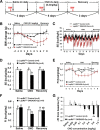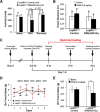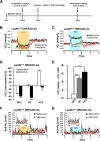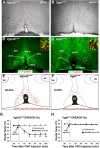Glutamatergic Preoptic Area Neurons That Express Leptin Receptors Drive Temperature-Dependent Body Weight Homeostasis
- PMID: 27147656
- PMCID: PMC4854966
- DOI: 10.1523/JNEUROSCI.0213-16.2016
Glutamatergic Preoptic Area Neurons That Express Leptin Receptors Drive Temperature-Dependent Body Weight Homeostasis
Abstract
The preoptic area (POA) regulates body temperature, but is not considered a site for body weight control. A subpopulation of POA neurons express leptin receptors (LepRb(POA) neurons) and modulate reproductive function. However, LepRb(POA) neurons project to sympathetic premotor neurons that control brown adipose tissue (BAT) thermogenesis, suggesting an additional role in energy homeostasis and body weight regulation. We determined the role of LepRb(POA) neurons in energy homeostasis using cre-dependent viral vectors to selectively activate these neurons and analyzed functional outcomes in mice. We show that LepRb(POA) neurons mediate homeostatic adaptations to ambient temperature changes, and their pharmacogenetic activation drives robust suppression of energy expenditure and food intake, which lowers body temperature and body weight. Surprisingly, our data show that hypothermia-inducing LepRb(POA) neurons are glutamatergic, while GABAergic POA neurons, originally thought to mediate warm-induced inhibition of sympathetic premotor neurons, have no effect on energy expenditure. Our data suggest a new view into the neurochemical and functional properties of BAT-related POA circuits and highlight their additional role in modulating food intake and body weight.
Significance statement: Brown adipose tissue (BAT)-induced thermogenesis is a promising therapeutic target to treat obesity and metabolic diseases. The preoptic area (POA) controls body temperature by modulating BAT activity, but its role in body weight homeostasis has not been addressed. LepRb(POA) neurons are BAT-related neurons and we show that they are sufficient to inhibit energy expenditure. We further show that LepRb(POA) neurons modulate food intake and body weight, which is mediated by temperature-dependent homeostatic responses. We further found that LepRb(POA) neurons are stimulatory glutamatergic neurons, contrary to prevalent models, providing a new view on thermoregulatory neural circuits. In summary, our study significantly expands our current understanding of central circuits and mechanisms that modulate energy homeostasis.
Keywords: DREADD; body temperature; body weight; energy expenditure; food intake; thermoregulation.
Copyright © 2016 the authors 0270-6474/16/365034-13$15.00/0.
Figures









References
Publication types
MeSH terms
Substances
Grants and funding
LinkOut - more resources
Full Text Sources
Other Literature Sources
Medical
Molecular Biology Databases
